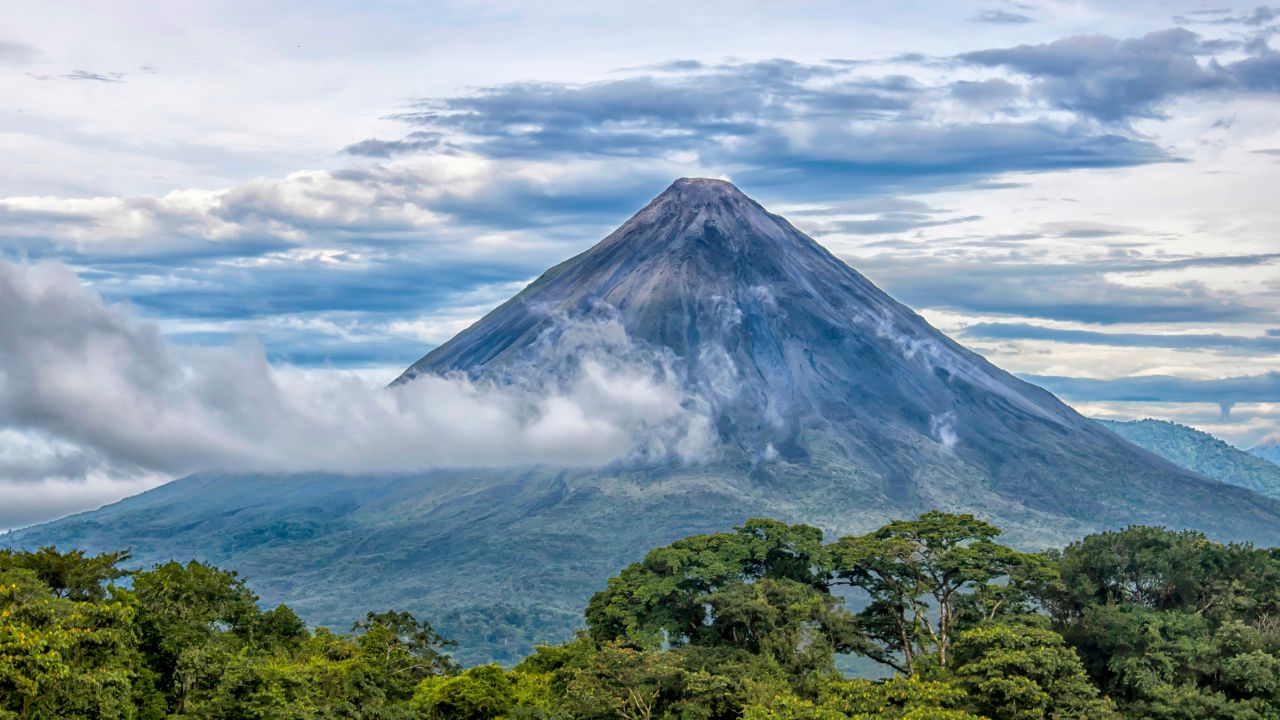Join us on a journey as we delve into the realm of Costa Rica’s volcanoes with our Volcano Tour Guide. This comprehensive guide will take you through their significance, historical importance, captivating local stories and myths, as well as the ongoing conservation efforts. Whether you’re a soulful adventurer, a nature lover, or simply curious about the world, Costa Rica’s volcanoes promise an array of experiences that will leave you in awe. So pack your bags and get ready to uncover the wonders of these breathtaking natural phenomena.
Volcanic Formation and Distribution
The remarkable volcanic scenery, in Costa Rica is a result of the forces that have shaped the region for millions of years. Situated in the Pacific Ring of Fire which encircles the Pacific Ocean like a horseshoe Costa Rica finds itself where several tectonic plates meet. The convergence of the Cocos Plate and the Caribbean Plate with the Plate has led to the captivating volcanic activity that defines this country.
The formation of Costa Ricas volcanoes is a process involving the subduction of the Cocos Plate beneath the Caribbean Plate. As the Cocos Plate descends into Earths mantle it experiences heat and pressure causing it to partially melt. The resulting molten rock, known as magma rises through cracks and weak points in Earths crust before reaching the surface through vents. This process gives birth to Costa Ricas peaks. Whether its Arenal Volcano with its shape or Irazú and Poás with their crater lakes each volcano has its own unique tale showcasing Earths fiery creativity.
The distribution of these volcanoes, throughout Costa Rica creates a tapestry of wonders for visitors to witness firsthand – an opportunity to observe firsthand how dynamic forces have shaped and continue to shape our world.
The Ring of Fire Connection
The wonders of Costa Ricas volcanoes are intricately connected to the movements of the Pacific Ring of Fire a known region, for its seismic and volcanic events. Stretching across the expanse of the Pacific Ocean this ring consists of subduction zones transform faults and volcanic arcs that encircle the ocean basin. Costa Ricas location within this fiery ring makes it a captivating destination for those in geology.
The Pacific Ring of Fire serves as an expression of Earths plate interactions. In Costa Ricas case the convergence of the Cocos Plate and the Caribbean Plate with the Plate creates an intriguing subduction zone. The Cocos Plate, a plate is gradually sliding beneath both the Plate and North American Plate. This subduction process gives rise to ocean trenches.
Eventually leads to magma rising to the surface resulting in volcanic peaks being formed. The interaction, between these plates not gives birth to volcanoes. Also triggers earthquakes and tsunamis making this region a hive of geological activity. It’s important to note that Costa Ricas volcanoes are not occurrences but partake in global natural processes that shape our planets very foundation.
Unveiling the Past: Cultural and Historical Significance of Costa Rica’s Volcanoes
Beyond their geological splendor, Costa Rica’s volcanoes hold a profound cultural and historical significance that stretches back centuries. For the indigenous peoples of the region, these fiery peaks were often revered as powerful deities or embodiments of natural forces. The Arenal Volcano, for instance, was considered sacred by the ancient Maleku people, who believed it to be the home of the fire goddess. These volcanoes were central to the spiritual fabric of indigenous communities, shaping their beliefs and rituals.
As European settlers arrived in Costa Rica, the cultural perception of volcanoes underwent transformation. The eruption of the Irazú Volcano in the 18th century left a lasting impact on the local population and even influenced the naming of Costa Rica’s capital, San José, which means “Saint Joseph.” The ash from the eruption coated the surroundings in a gray hue, leading to the city’s nickname, “City of the Ashes.” The historic eruptions of these volcanoes are recorded in the annals of Costa Rican history, and they often played pivotal roles in shaping the nation’s identity and development.
Today, the cultural and historical legacy of Costa Rica’s volcanoes continues to thrive. Visitors have the opportunity to delve into the stories, myths, and legends that have been passed down through generations. Exploring the connection between the land and its people adds a layer of depth to the volcanic experience, reminding us that these majestic peaks are not just geological wonders, but integral components of Costa Rica’s rich cultural tapestry.
Indigenous Beliefs and Legends
The indigenous cultures of Costa Rica have long held profound beliefs and legends that intertwine with the awe-inspiring presence of volcanoes. These towering giants were often regarded as the dwellings of powerful spirits and gods, shaping the spiritual narratives of the native peoples. Among the Bribri and Cabécar communities, the Turrialba Volcano is considered the home of Sibö, the creator deity who molds the world’s landscape and lifeforms. These volcanoes were not just geographical features; they were living entities with personalities and intentions, commanding both respect and reverence.
Legends surrounding volcanic eruptions often held deep cultural significance. The eruption of the Poás Volcano was seen as a reflection of Pele, the Hawaiian goddess of fire and volcanoes, unleashing her wrath. The indigenous Boruca people of Costa Rica’s southern highlands also recounted stories of fiery battles between the god of thunder and the volcano, portraying the eternal struggle between natural forces. These narratives not only conveyed the power and unpredictability of volcanic activity but also reinforced the interdependence between humans and the natural world.
While modernization and globalization have led to shifts in cultural practices, many indigenous communities still maintain a strong connection to their ancestral beliefs and legends. Visiting these communities provides an opportunity to engage with their stories and gain insights into their profound respect for nature.
The indigenous perspective offers a unique lens through which to appreciate Costa Rica’s volcanoes as more than just geological formations, but as living entities intertwined with the spiritual essence of the land.
Roaming Among Legends: Local Stories and Myths Surrounding the Volcanoes
The indigenous cultures of Costa Rica have long held profound beliefs and legends that intertwine with the awe-inspiring presence of volcanoes. These towering giants were often regarded as the dwellings of powerful spirits and gods, shaping the spiritual narratives of the native peoples. Among the Bribri and Cabécar communities, the Turrialba Volcano is considered the home of Sibö, the creator deity who molds the world’s landscape and lifeforms. These volcanoes were not just geographical features; they were living entities with personalities and intentions, commanding both respect and reverence.
Legends surrounding volcanic eruptions often held deep cultural significance. The eruption of the Poás Volcano was seen as a reflection of Pele, the Hawaiian goddess of fire and volcanoes, unleashing her wrath. The indigenous Boruca people of Costa Rica’s southern highlands also recounted stories of fiery battles between the god of thunder and the volcano, portraying the eternal struggle between natural forces. These narratives not only conveyed the power and unpredictability of volcanic activity but also reinforced the interdependence between humans and the natural world.
While modernization and globalization have led to shifts in cultural practices, many indigenous communities still maintain a strong connection to their ancestral beliefs and legends. Visiting these communities provides an opportunity to engage with their stories and gain insights into their profound respect for nature. The indigenous perspective offers a unique lens through which to appreciate Costa Rica’s volcanoes as more than just geological formations, but as living entities intertwined with the spiritual essence of the land.
The Tale of Arenal: The Sleeping Giant Awakens
Nestled within the landscapes of Costa Rica lies a fascinating story, about the Arenal Volcano. This tale perfectly mirrors the changing nature of our planet. For centuries Arenal stood peacefully covered in mist and surrounded by an air of mystery. Fondly referred to as the “Sleeping Giant ” it offered communities a sense of tranquility while serving as a reminder of the powerful forces that have shaped our land.
However in the middle of the century Arenal’s narrative took a twist. In 1968 with an powerful event the “Sleeping Giant” awakened in a truly spectacular manner. Arenal erupted with force after centuries of dormancy spewing rock and ash into the sky. This eruption forever transformed the landscape. Left a mark on everyones memory in the region. The dormant giant had come alive again becoming a living symbol of our Earths nature.
The story of Arenal is one that showcases resilience and transformation—a reminder that seemingly inactive elements, in nature can spring to life with incredible energy. Today the majestic presence of Arenal attracts travelers who yearn to witness the enduring story of our planets history. The verdant.
Rejuvenating springs that now envelop its slopes offer a striking contrast, to its tumultuous past prompting us to contemplate the profound cycle of birth and destruction that shapes our world. As we admire the awakened Arenal we become entranced by the captivating narrative of a giant transformed into a vibrant narrator of Earths limitless energy.
The Enigmatic Poás: Mythology and Reality
Nestled within the embrace of Costa Rica’s Central Valley, the Poás Volcano stands as a living enigma, a blend of mythology and geological marvel. Its vast crater, filled with an otherworldly aquamarine lake, has fueled both scientific curiosity and imaginative tales. Among the locals, the story of Poás is steeped in legend and myth, adding an ethereal layer to its already captivating presence.
One of the most enduring legends surrounding Poás is the tale of star-crossed lovers. It is said that a forbidden love between a young indigenous couple led them to seek solace on the shores of the volcano’s lake. Their love, too intense for the world to endure, was said to have transformed them into birds, forever bound to circle the crater’s edge. This romantic tale has been passed down through generations, offering a glimpse into the human desire to weave narrative threads through the natural world.
Beyond its mythical allure, Poás also offers a window into the Earth’s inner workings. The volcanic activity that has shaped its landscape is undeniable, with regular emissions of gas and steam serving as a reminder of the Earth’s restless energy. The juxtaposition of its mystical tales and the very real geological processes occurring within its depths makes Poás a realm where mythology and reality coexist, inviting visitors to ponder the intricate connections between culture and nature, myth and science.
Nestled in the region of Costa Rica you’ll find the Rincón de la Vieja Volcano, a true wonder of nature. This active stratovolcano takes stage in Rincón de la Vieja National Park, a realm of natural beauty and diverse ecosystems. The volcanos rugged landscape serves as a haven, for enthusiasts providing an array of activities that cater to everyones interests.
From exploring craters to uncovering hidden waterfalls and indulging in the soothing warmth of hot springs there’s something for everyone here. As you venture along the parks trails that wind through forests you’ll be serenaded by the calls of howler monkeys. Treated to vibrant flashes of colorful birds.
One fascinating highlight within Rincón de la Vieja is Las Pailas, an area adorned with bubbling mud pots steaming fumaroles and sulfurous vents. These geothermal features serve as a reminder of the volcanos core while offering a captivating glimpse into the Earths workings. Nearby lies the tranquil Oropendola Waterfall cascading into a pool—an inviting oasis, for adventurers seeking a dip.
For those craving adventure Rincón de la Vieja National Park also boasts hanging bridges that provide views of the forest canopy—a perfect vantage point to witness its abundant biodiversity. Rincón de la Vieja Volcano truly captures the essence of Costa Ricas beauty with its geological features and captivating plant and animal life.
Unique Flora and Fauna
Costa Rica’s volcanic landscapes offer a haven for a breathtaking variety of flora and fauna that have adapted to the distinct microclimates and habitats created by these geological wonders. From the tropical rainforests at the base of the volcanoes to the cloud forests that shroud their upper slopes, these ecosystems harbor an incredible richness of life. Orchids of vibrant hues, towering tree ferns, and a plethora of mosses and epiphytic plants create a tapestry of colors and textures that seem almost surreal.
The diversity of wildlife is equally astounding. Bird enthusiasts will be thrilled to encounter the resplendent quetzal and the elusive three-wattled bellbird in the Monteverde Cloud Forest, while the lush forests around Arenal are home to a multitude of colorful toucans, trogons, and hummingbirds.
Sloths, howler monkeys, and capuchin monkeys are often spotted swinging through the treetops, while the endangered Baird’s tapir and the elusive ocelot wander through the undergrowth. The volcanic soils also provide a fertile ground for amphibians and reptiles, including the iconic red-eyed tree frog and the emerald basilisk, known as the “Jesus Christ lizard” for its ability to walk on water.
The delicate balance of these ecosystems relies on the preservation of both plant and animal species. Conservation efforts are not just about protecting the beauty of these landscapes, but about safeguarding the habitats that support an intricate web of life. As you explore Costa Rica’s volcanoes, you’ll discover that every step unveils a world of incredible biodiversity, reminding us of the importance of preserving these natural treasures for generations to come.
Guardians of Biodiversity: Eco Conservation Efforts around Costa Rica’s Volcanoes
Costa Rica’s volcanoes not only shape the landscape but also play a crucial role in fostering rich biodiversity. These towering giants, with their diverse microclimates and unique ecosystems, have spurred dedicated conservation efforts aimed at preserving the delicate balance of life they support. The lush cloud forests, lush valleys, and verdant slopes surrounding the volcanoes are home to a remarkable array of plant and animal species, many of which are endemic and found nowhere else on Earth.
Conservationists and local communities have joined hands to protect these natural treasures. Organizations like the Arenal Conservation Area work tirelessly to safeguard the flora and fauna that call the area around the Arenal Volcano home. By creating protected areas, establishing sustainable tourism practices, and engaging in reforestation projects, these initiatives ensure that the ecosystems remain intact for future generations to appreciate and study.
The volcanic landscapes also serve as vital water catchment areas, providing freshwater for surrounding regions. The Irazú Volcano, for example, plays a crucial role in maintaining the water supply for San José, Costa Rica’s capital city. Recognizing the interconnectedness of these ecosystems and the well-being of both human and non-human inhabitants, these conservation efforts serve as a testament to Costa Rica’s commitment to sustainable development and its role as a steward of its natural heritage.
Conservation Challenges and Initiatives
While the volcanic landscapes of Costa Rica are awe-inspiring, they are not immune to the challenges posed by human activity and environmental changes. Urbanization, agricultural expansion, and tourism development can all exert pressure on these delicate ecosystems. The delicate balance between promoting tourism and ensuring conservation remains a significant challenge. The footprints of increased visitors can disrupt habitats and introduce invasive species, threatening the fragile flora and fauna that call these areas home.
However, Costa Rica has responded to these challenges with a proactive approach to conservation. The country’s commitment to preserving its natural heritage is exemplified by its extensive network of protected areas and national parks. Organizations, both governmental and non-governmental, collaborate to establish sustainable tourism practices, enforce regulations, and engage in community education.
The creation of buffer zones around protected areas helps mitigate the impact of development, allowing wildlife corridors to thrive. By emphasizing eco-tourism and promoting responsible travel, Costa Rica seeks to strike a balance between sharing the beauty of its volcanoes with the world and safeguarding their ecosystems.
Innovative conservation initiatives include the establishment of biological corridors that connect various protected areas, allowing for the movement of wildlife across landscapes. Reforestation projects, community-based conservation efforts, and scientific research contribute to a holistic approach to preserving these volcanic ecosystems. The challenges may be complex, but the dedication to finding solutions is evident, reflecting Costa Rica’s enduring commitment to being a global leader in sustainable conservation practices.
Timing Your Adventure: Best Seasons for Exploring Costa Rica’s Volcanoes
When it comes to exploring the wonders of Costa Rica the timing of your visit can greatly impact your experience. The country’s distinct wet and dry seasons play a role, in determining the accessibility and overall atmosphere of the landscapes.
The dry season, which usually spans from December to April is widely favored by visitors. During these months you can expect skies, warm temperatures and low rainfall. It’s a time for activities like hiking, birdwatching and capturing the breathtaking views that the volcanoes offer.
However don’t underestimate the season from May to November. Although rain is more frequent during this period it brings greenery and a burst of life to these landscapes. The forests become alive with activity and the waterfalls scattered across the terrain are at their impressive.
The wet season provides an opportunity to witness mist covered volcanoes enveloped in an ambiance—a dream come true for photographers. Additionally there are crowds during this time allowing for an intimate and serene encounter, with Costa Ricas natural wonders.
To plan your adventure exploring these volcanoes effectively it’s essential to understand the characteristics of each season.
Whether you’re enticed by the liveliness of the season or captivated by the charm of the wet season Costa Rica’s volcanoes offer an alluring experience throughout the year.
Dry Season vs. Rainy Season
Costa Rica’s volcanoes have a charm during both the rainy seasons each offering their own special attractions and things to consider. From December, to April the dry season brings skies, plenty of sunshine and minimal rainfall. It’s the time for adventures with easier access to hiking trails and breathtaking panoramic views from the volcano peaks.
Exploring the ecosystems surrounding these volcanoes becomes more enjoyable during this season whether its trekking through lush rainforests or relaxing by tranquil crater lakes. This is also a time for tourists creating an atmosphere where you can connect with fellow travelers.
On the hand from May to November Costa Rica reveals another side of its landscapes during the rainy season. Although there are rain showers during this period they are usually brief and give way to an enchanting emerald landscape adorned with vibrant flora and cascading waterfalls. The rainy season offers a quieter and experience as smaller crowds allow you to fully immerse yourself in the serene beauty of nature. It’s also a time for birdwatching since many bird species are more active, during this period.
In the end your decision, between the rainy seasons in Costa Rica depends on what you prefer and the kind of experience you’re looking for. Whether you’re attracted to days and vibrant trails or the enchanting charm of rainforests and serene encounters, with nature Costa Rica’s volcanoes are always prepared to showcase their magnificence regardless of the season.
Face to Face with Fire: What to Expect When Visiting Each Volcano
Each of Costa Rica’s volcanoes offers a unique and captivating experience, allowing visitors to come face to face with the raw power and beauty of the Earth’s volcanic activity. The Arenal Volcano, known as one of the world’s most active volcanoes until 2010, presents a dynamic landscape of lush rainforests and steaming vents.
Adventurous travelers can embark on hikes through lava fields and dense vegetation, while relaxation-seekers can unwind in the natural hot springs that abound in the area. The volcano’s rumbling and occasional nighttime eruptions provide an awe-inspiring backdrop to the adventure.
The Poás Volcano, famed for its striking turquoise crater lake, offers a different kind of encounter. Visitors can witness the geothermal activity up close, peering into the fumaroles and appreciating the eerie beauty of the steaming vents. The trek to the crater’s edge is rewarded with breathtaking views that span across the expanse of the crater and its vibrant lake. The Irazú Volcano, the tallest in Costa Rica, boasts a dramatic, moon-like landscape at its summit.
Here, visitors can gaze into the colossal crater that houses a stunning turquoise-green lake. On clear days, the panoramic views from Irazú’s peak extend to both the Caribbean and Pacific coasts, offering an unparalleled perspective on the country’s geography.
Each volcano provides a unique experience, from hiking through diverse ecosystems to marveling at the forces that have shaped the Earth’s surface. Whether you’re a nature enthusiast, a thrill-seeker, or a curious traveler, the opportunity to stand in the presence of these awe-inspiring volcanoes is an experience that’s bound to leave an indelible mark on your memory.
Arenal Volcano – The Majestic Masterpiece
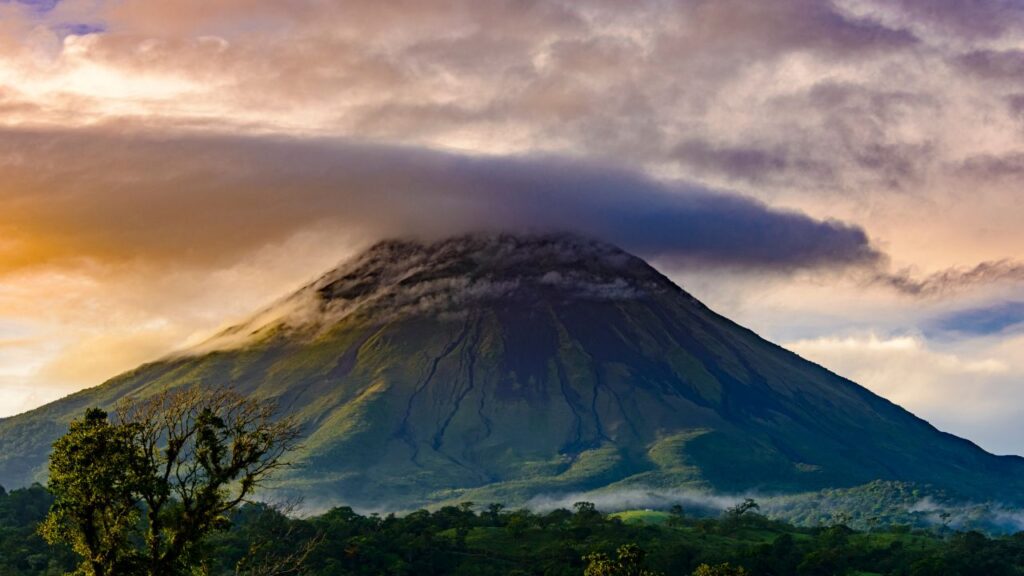
A Comprehensive Guide to the Volcanoes of Costa Rica 13
Rising gracefully from the lush rainforests of Costa Rica, the Arenal Volcano is a true masterpiece of nature’s artistry. With its iconic conical shape and imposing presence, it has captured the imagination of visitors and locals alike. Once referred to as the “Sleeping Giant,” Arenal erupted dramatically in 1968, reshaping the surrounding landscape and announcing its dynamic awakening. Today, it stands as a symbol of the Earth’s ceaseless transformation.
Adventure-seekers are drawn to Arenal’s slopes for exhilarating treks through varied terrain, where trails wind through primary and secondary rainforests, offering glimpses of vibrant flora and fauna. One of the volcano’s defining features is the series of hot springs that owe their warmth to the geothermal activity beneath. These natural thermal baths provide a soothing respite, allowing visitors to relax in warm mineral-rich waters surrounded by the verdant beauty of the rainforest.
Arenal’s nocturnal eruptions have provided a mesmerizing spectacle for those fortunate enough to witness them, painting the night sky with fiery streaks. And while its eruptive phase ended in 2010, Arenal remains an active volcano that continues to shape the environment around it.
Whether you’re immersing yourself in the healing waters of the hot springs, hiking to observation points for panoramic views, or marveling at its history and power, Arenal Volcano’s majestic presence offers an adventure that seamlessly blends natural wonder with the thrill of exploration. The Arenal Volcano region isn’t just known for its volcanic majesty; it’s also a hub of exhilarating adventures and therapeutic relaxation. One of the region’s most iconic features is its abundance of natural hot springs, created by the geothermal activity beneath the Earth’s surface.
These warm, mineral-rich waters provide a soothing escape from the everyday hustle and bustle, allowing visitors to unwind amidst the lush surroundings. From luxurious resorts with meticulously designed pools to more secluded, hidden gems, the hot springs offer a rejuvenating experience that harmoniously melds nature’s tranquility with the comfort of indulgence.
For thrill-seekers, the Arenal area offers a playground of exciting activities. Ziplining through the rainforest canopy offers breathtaking views of both the volcano and its verdant surroundings. Rappelling down waterfalls and horseback riding along scenic trails are other popular options that allow adventurers to immerse themselves in the region’s dynamic beauty.
Arenal’s volcanic history also lends itself to unique opportunities such as hiking along lava fields and exploring underground caves formed by ancient lava flows. And for the ultimate adrenaline rush, white-water rafting on the Sarapiquí River promises a wild ride through the heart of the rainforest.
Whether you’re seeking relaxation or adventure (or a bit of both), the Arenal Volcano region offers an irresistible blend of experiences. From soaking in healing waters under starlit skies to embarking on heart-pounding escapades surrounded by nature’s splendor, this volcanic haven invites you to indulge your senses and create unforgettable memories.
Irazú Volcano – The Colossal Cauldron

A Comprehensive Guide to the Volcanoes of Costa Rica 14
Dominating the skyline and offering panoramic vistas that stretch from coast to coast, the Irazú Volcano stands as a colossal cauldron of geological wonder. As the tallest volcano in Costa Rica, Irazú commands attention with its towering presence and a history that’s etched into the landscape. Its summit reveals a lunar-like expanse, with its massive crater boasting a serene, turquoise-green lake at its center. This stunning body of water, known as Diego de la Haya, adds an ethereal touch to the volcanic experience.
A visit to Irazú is an opportunity to stand in awe at the intersection of raw power and breathtaking beauty. The drive to the summit takes you through changing ecosystems, showcasing the diverse range of flora and fauna that thrive at different altitudes. On a clear day, the panoramic view from the summit’s lookout points is unparalleled – you’ll witness the sparkling Caribbean Sea on one side and the mighty Pacific Ocean on the other. As you stand at the rim of the crater, the contrast between the tranquil turquoise lake and the immense volcanic crater is a sight that’s nothing short of awe-inspiring.
Exploring Irazú’s unique landscape offers an insight into the geological forces that shape our planet. Whether you’re hiking along the trails that wind through the surrounding cloud forest, marveling at the dramatic changes in vegetation, or contemplating the vastness of the crater before you, the Irazú Volcano presents an opportunity to connect with the Earth’s history and its enduring processes.
The Irazú Volcano’s crown jewel is undoubtedly its breathtaking crater lake, a mesmerizing expanse of turquoise that mirrors the sky and captures the imagination. Known as Diego de la Haya, this serene body of water is nestled within the colossal volcanic crater, creating a visual spectacle that is both serene and surreal.
The color of the lake shifts between shades of blue and green, influenced by the interplay of sunlight and minerals within the water. This stunning natural masterpiece invites visitors to pause and reflect, as they witness the harmonious blend of geological forces and natural beauty.
Beyond the allure of the crater lake, the Irazú Volcano area is rich in other attractions as well. The surrounding landscapes beckon with opportunities for exploration, hiking, and birdwatching. Trails meander through cloud forests, offering glimpses of endemic flora and fauna, and leading to viewpoints that reveal the volcanic wonders below.
The Prusia Forest, located nearby, provides a tranquil escape with trails that wind through a unique and diverse ecosystem. For those interested in history, the town of Cartago, with its colonial architecture and the revered Basilica of Our Lady of the Angels, is a cultural and spiritual highlight.
As you explore the Irazú Volcano region, the juxtaposition of the vibrant crater lake against the backdrop of its volcanic history creates an experience that’s both humbling and inspiring. Whether you’re capturing the captivating hues of the lake on camera, hiking through lush landscapes, or delving into the rich heritage of Cartago, the area surrounding Irazú offers an enchanting tapestry of natural and cultural treasures waiting to be discovered.
Poás Volcano – Mythology and the Majestic Crater
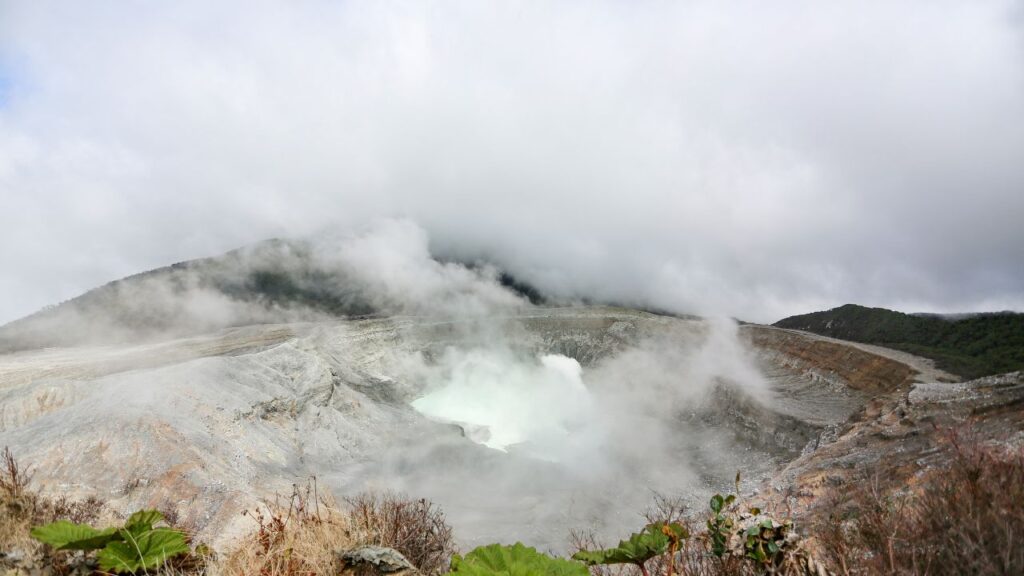
A Comprehensive Guide to the Volcanoes of Costa Rica 15
Nestled within the lush Central Valley of Costa Rica, the Poás Volcano beckons with a unique blend of mythology and geological marvels. At its heart lies a crater that holds a fabled and captivating history.
The main attraction of Poás is its active main crater, which is home to a striking turquoise-green lake, a surreal sight that seems almost magical. Visitors are treated to the spectacle of geothermal activity as they observe the billowing steam and gas that escape from the fumaroles, adding an air of mystique to the experience.
But the allure of Poás extends beyond its geologic wonders; it’s also steeped in local legend. According to indigenous tales, the crater was formed from the tears of a powerful sorceress who was unable to find her son. This blend of mythology and reality infuses Poás with an enchanting aura that’s hard to resist.
The national park that encompasses the volcano provides hiking trails that wind through cloud forests and lead to lookout points offering panoramic views of the majestic crater. Whether you’re drawn by the mysticism of its tales or the captivating vistas of its geothermal activity, Poás Volcano promises an experience that’s as unique as the legend that surrounds it.
Turrialba Volcano. Majestic and Active Amidst the Clouds. Majestic and Active Amidst the Clouds

A Comprehensive Guide to the Volcanoes of Costa Rica 16
Situated as a guardian, over the Central Valley Turrialba Volcano has gained attention in years due to its series of eruptions. This dynamic stratovolcano provides an opportunity to witness the processes that shape our planets surface. While occasional closures of the park have resulted from these eruptions the surrounding area still holds an abundance of cloud forests picturesque landscapes and an extraordinary assortment of biodiversity.
For explorers seeking a remote and untouched experience Turrialba Volcano is a must visit destination. The trails meandering through the park offer a close encounter with this volcanos history and its impact on the surroundings. This region exudes tranquility, where one can find solace in the rustling of leaves and distant melodies of birdsong.
The park is home to a range of wildlife species, including felines like jaguars and pumas as well, as vibrant quetzals and resplendent trogons. Turrialba’s majestic splendor and abundant biodiversity have consistently captivated adventurers beckoning them to embrace its allure and forge a connection, with the ever evolving wonders of our planet.
Tenorio Volcano. A Magical Destination, with Blue Waters and Lush Greenery
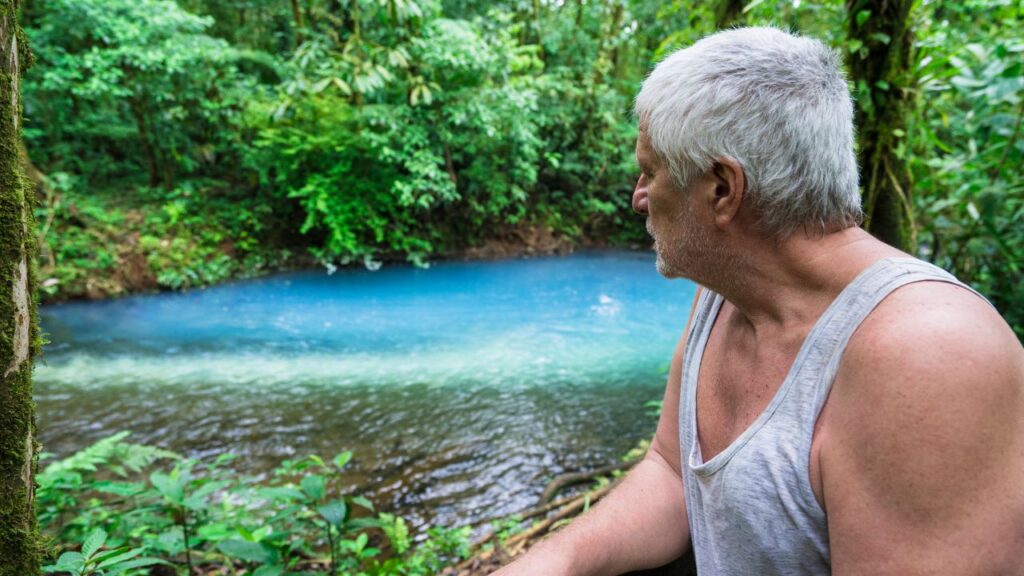
A Comprehensive Guide to the Volcanoes of Costa Rica 17
Nestled in the captivating Tenorio Volcano National Park, the Tenorio Volcano presents a unique and mystical experience that leaves a lasting impression on those who visit. The highlight of this wonder is the mesmerizing sky waters of the Rio Celeste, a renowned river known for its enchanting hue. This awe-inspiring phenomenon is caused by the interaction of minerals and chemical reactions in the water creating a spectacle that beautifully contrasts with the surrounding landscape.
As you embark on a hike through the forests of Tenorio Volcano National Park you’ll witness firsthand the enchantment that unfolds around every corner. The trail leads to the Rio Celeste Waterfall, where crystal clear waters gracefully cascade into a tranquil pool inviting visitors to immerse themselves in its splendor.
The parks maintained pathways wind through both secondary rainforests offering abundant opportunities to observe diverse wildlife such, as monkeys, sloths, and an array of bird species. These distinct ecosystems brilliantly showcase how volcanic activity harmoniously coexists with flourishing life forms truly captivating nature enthusiasts and photographers alike.
Located in the landscapes of Costa Rica the Miraval’s Volcano may not be as well known as some of its counterparts but it provides an unforgettable journey, into the wonders of geothermal activity and untouched natural beauty. This dormant stratovolcano is part of a complex that supplies renewable energy to the surrounding area. The hot springs and bubbling mud pots serve as evidence of the forces that shape this region’s captivating landscape.
However Miraval’s offers more than marvels. It is a paradise for adventurers seeking off the beaten path experiences. Trails meander through rainforests leading to hidden waterfalls that cascade into tranquil pools creating oases amidst the abundant greenery. Moreover exploring Miraval’s provides an opportunity to understand the processes behind energy generation. As you indulge in the springs while being serenaded by natures symphony you’ll develop a deep appreciation, for how Earths inner energy harmoniously coexists with surface tranquility.
Orosí Volcano – Majestic Presence in Orosí Valley
Nestled within the enchanting Orosí Valley, the Orosí Volcano stands as a testament to Costa Rica’s geological diversity. Unlike its active counterparts, Orosí is an extinct volcano that has left behind a legacy of beauty and tranquility. The picturesque landscapes surrounding the volcano are adorned with coffee plantations, rolling hills, and a serene lake that reflects the surrounding greenery. The town of Orosí itself boasts colonial charm, with its historic church and cobblestone streets adding to the area’s allure.
Visitors to Orosí can embark on hikes that take them through lush cloud forests, where they can spot a variety of bird species and immerse themselves in the symphony of nature. The nearby Tapantí National Park is a haven for those seeking solitude and a chance to connect with pristine natural beauty. The Orosí Valley showcases a different side of Costa Rica’s volcanic landscapes—one that’s characterized by tranquility, history, and the vibrant culture of the surrounding communities.
Barva Volcano – Cloud Forest Beauty and Hidden Trails
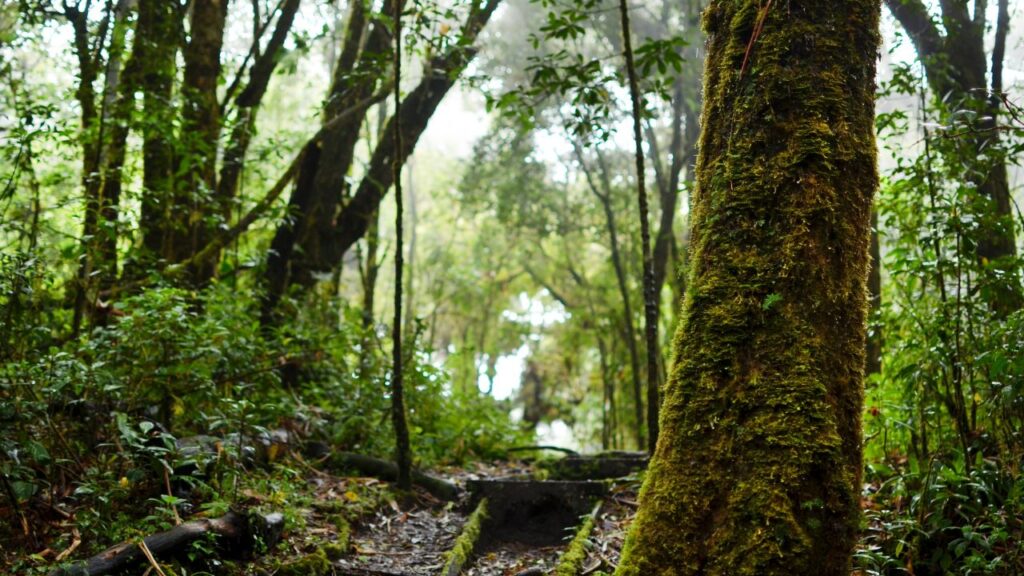
A Comprehensive Guide to the Volcanoes of Costa Rica 18
Nestled within the Braulio Carrillo National Park, the Barva Volcano offers a unique opportunity to explore cloud forests and hidden trails that lead to breathtaking vistas. This dormant volcano is part of a larger volcanic complex and stands as a testament to Costa Rica’s commitment to preserving its natural heritage. The park’s landscapes are characterized by a lush expanse of cloud forest, a haven for diverse flora and fauna that thrive in the cool, misty environment.
Barva’s trails wind through the cloud forest, allowing visitors to immerse themselves in an ecosystem that’s teeming with life. The La Paz Waterfall Gardens, located near the volcano, offer a chance to witness the power and beauty of cascading water as it tumbles through the lush vegetation.
As you explore Barva’s trails, you’ll encounter hidden treasures that include serene lagoons and panoramic viewpoints that provide sweeping vistas of the surrounding landscapes. Barva Volcano beckons those seeking a more off-the-beaten-path experience, inviting them to uncover the hidden beauty and diverse life that thrive within the cloud forests of Costa Rica.
Cacao Volcano – Remote Splendor and Unspoiled Beauty
Nestled near the Turrialba Volcano, the Cacao Volcano is part of the same volcanic complex and offers a remote, unspoiled landscape that’s perfect for those seeking solitude and serenity. This dormant volcano is enveloped by lush cloud forests, creating an environment that’s rich in biodiversity and untouched beauty. The trails that wind through the surrounding forests provide a chance to immerse yourself in the sights and sounds of nature, where the calls of birds and the rustling of leaves create a tranquil symphony.
Cacao’s remote location makes it a hidden gem for hikers and nature enthusiasts. As you explore the trails, you’ll be rewarded with panoramic views of the surrounding landscapes, as well as a sense of tranquility that comes from being in a less-visited area. The volcano’s serene atmosphere and pristine beauty offer a contrast to some of Costa Rica’s more popular destinations, making it a unique and captivating place to connect with nature and experience the raw beauty of the volcanic landscape.
Guided Expeditions and Luxurious Retreats: Resorts and Tours
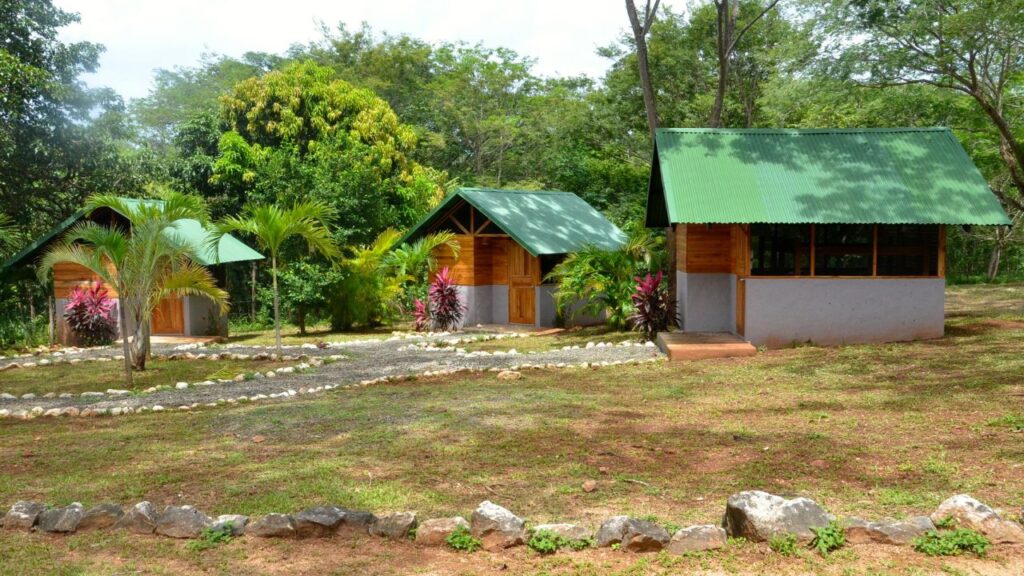
A Comprehensive Guide to the Volcanoes of Costa Rica 19
Exploring Costa Rica’s volcanic landscapes is not just a journey into nature; it’s an invitation to embrace a world of guided expeditions and luxurious retreats that cater to various tastes and preferences. For the adventure enthusiasts, a myriad of guided tours offer the chance to delve deep into the heart of the volcanoes.
Expert guides lead treks along well-maintained trails, offering insights into the geological marvels and biodiversity that make these areas so captivating. From lava field hikes to nocturnal volcano-watching excursions, these tours provide a blend of excitement and education.
On the other end of the spectrum, Costa Rica’s volcanic regions are also home to luxurious retreats that provide a haven for relaxation and pampering. Resorts and lodges nestled in the midst of natural splendor offer tranquil escapes for travelers seeking comfort and rejuvenation.
Many of these establishments boast their own thermal springs, allowing guests to soak in warm mineral waters while surrounded by the beauty of the volcanic landscapes. Spa treatments inspired by local traditions, gourmet cuisine featuring regional flavors, and stunning vistas create a holistic experience that blends opulence with the natural world.
Whether you’re an adrenaline junkie seeking the thrill of adventure or a traveler yearning for a peaceful retreat, Costa Rica’s volcanic regions have something to offer. The guided expeditions and luxurious resorts not only allow you to witness the volcanoes’ splendor but also to immerse yourself in the diverse facets of these breathtaking landscapes. From heart-pounding hikes to tranquil soaks, the options are as varied as the volcanic wonders themselves.
Adventure Tours: Trekking and Lava Watching
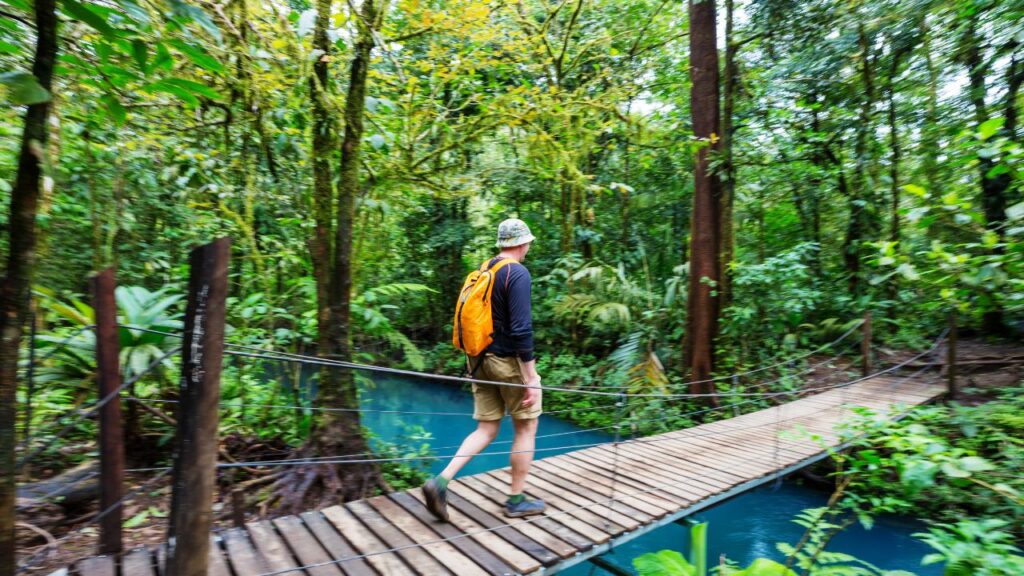
A Comprehensive Guide to the Volcanoes of Costa Rica 20
For the intrepid explorers seeking an adrenaline-fueled experience, Costa Rica’s volcanic terrains offer a playground of adventure tours that promise to ignite the spirit of discovery. Guided trekking excursions lead you through diverse ecosystems, from dense rainforests alive with the sounds of exotic birds to rugged lava fields that bear witness to the volcanic forces that have shaped the land.
These treks often culminate at lookout points that offer panoramic vistas of the majestic volcanoes and the surrounding landscapes, creating opportunities for awe-inspiring photography and contemplation.
Lava watching is another exhilarating adventure that brings you up close and personal with the primal forces of nature. Guided nighttime tours offer a chance to witness the mesmerizing spectacle of molten lava flowing down the slopes of active volcanoes. As darkness falls, the lava’s incandescent glow paints the night with fiery hues, creating a surreal and unforgettable experience.
Expert guides share their knowledge about volcanic activity, geology, and the local ecosystem, providing a holistic understanding of the forces at play. These lava watching tours not only satisfy the curiosity of adventure seekers but also evoke a deep sense of wonder and respect for the Earth’s inner workings.
Costa Rica’s adventure tours are designed to connect you with the raw energy of the volcanoes, inviting you to step out of your comfort zone and immerse yourself in the captivating beauty and power of the natural world. From trekking through lush rainforests to witnessing the fiery dance of molten lava, these tours offer an extraordinary opportunity to create lasting memories and forge a deep connection with the landscapes that have shaped Costa Rica’s identity.
Relaxation Retreats: Hot Springs and Spa Resorts
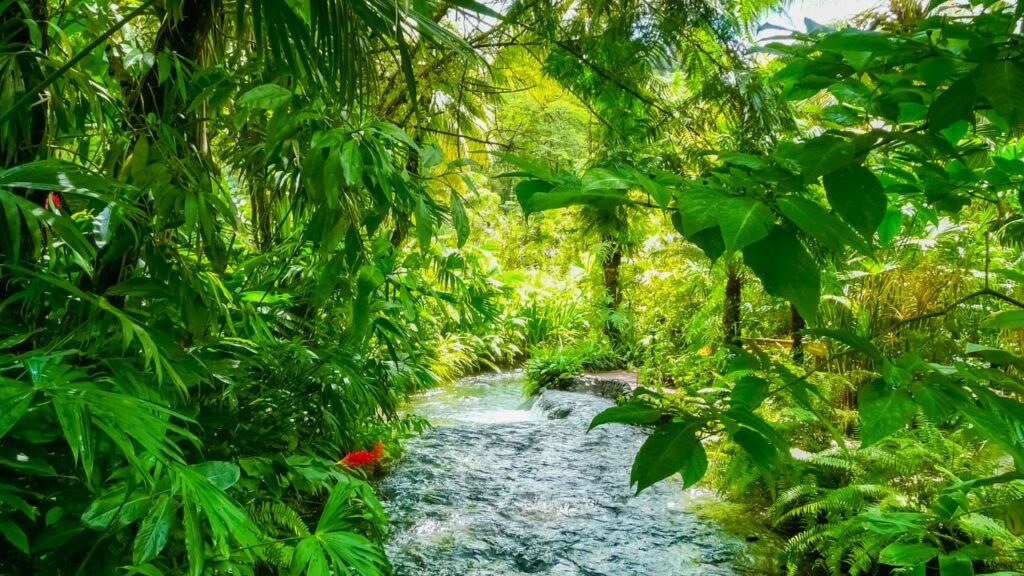
A Comprehensive Guide to the Volcanoes of Costa Rica 21
For those seeking solace and rejuvenation, Costa Rica’s volcanic regions offer a haven of relaxation retreats that blend the tranquil beauty of nature with the comforts of luxurious accommodations. The natural hot springs that emerge from the Earth’s geothermal depths have been harnessed to create serene oases of relaxation.
Nestled amidst lush forests, these hot springs invite you to soak in their warm, mineral-rich waters, surrounded by the symphony of rustling leaves and distant bird calls. The therapeutic properties of these springs, combined with the soothing ambiance, offer a rejuvenating experience that nurtures both body and soul.
Surrounding these hot springs are exquisite spa resorts that provide an array of treatments inspired by the region’s natural bounty. From volcanic mud masks that detoxify the skin to massages that draw on local techniques, these spa experiences are a testament to Costa Rica’s commitment to holistic wellness.
Yoga and meditation sessions amidst the serene landscapes allow guests to find harmony and balance, while healthy and locally sourced cuisine nourishes the body from within. The combination of soothing waters, attentive hospitality, and the enchanting beauty of the volcanic surroundings creates a retreat that embraces relaxation on every level.
Costa Rica’s hot springs and spa resorts offer an opportunity to disconnect from the demands of daily life and reconnect with nature’s healing embrace. As you unwind in the warm waters, surrounded by the sights and sounds of the rainforest, a sense of serenity washes over you. These relaxation retreats offer a sanctuary for self-care, a space where you can let go of stress and embrace a state of tranquility in the heart of Costa Rica’s volcanic paradise.
Frequently Asked Questions about Costa Rica’s Volcanoes
Are the volcanoes in Costa Rica to visit?
Costa Rica’s volcanoes are closely monitored by experts and it is generally considered safe to visit them. However it is important to adhere to park regulations stay within designated areas and follow any advisories provided by authorities.
Can I witness lava flows at the volcanoes?
While some volcanoes have had lava flows in the past such as Arenal there is no guarantee of flows. The best opportunity to see lava activity is during guided tours specifically designed for lava watching.
What is the recommended time to visit Costa Rica’s volcanoes?
The dry season, which falls between December and April offers conditions with views and opportunities for outdoor activities. On the hand the wet season from May to November provides landscapes fewer crowds and lower prices.
Do I need a guide to explore the volcanoes?
Although some trails can be explored independently having a knowledgeable guide can greatly enhance your experience. They can provide insights into the geology, flora, fauna while ensuring your safety.
Are there accommodations, near the volcanoes?
Yes indeed! There are resorts, lodges and hotels located around the regions that offer a range of accommodation options catering to different budgets and preferences.
Many resorts even have their hot springs for guests to enjoy and relax in.
Are the parks surrounding the volcanoes for people of all fitness levels?
Most of the national parks offer a range of trails suitable, for different fitness levels, including easy walks for leisurely strolls and more challenging hikes for those seeking a bit of adventure. It’s advisable to research the park and trail before your visit to find the fit for you.
What kind of wildlife can be observed around the volcanoes?
Costa Rica’s volcanoes are known for their biodiversity. You’ll have the opportunity to spot species, including birds like toucans and quetzals playful monkeys slow moving sloths, as well as reptiles such as iguanas and snakes.
Is it allowed to swim in the crater lakes?
For safety reasons and conservation purposes swimming in crater lakes is generally not permitted. The water in these lakes can be acidic or contain minerals that could be harmful to both humans and the environment.
Are there any experiences near the volcanoes?
Absolutely! Nearby towns like La Fortuna offer a range of experiences where you can immerse yourself in traditions. Explore cuisine at eateries visit artisan markets showcasing handmade crafts or even engage with indigenous communities to learn more about their way of life.
What essentials should I pack when visiting a volcano?
When preparing for your volcano visit it’s important to pack. Be ready for varying weather conditions by bringing hiking shoes, layers of clothing for both rain and sunshine insect repellent to ward off bugs sunscreen to protect your skin from sunburns, a hat for sun protection or shade during hikes a rain jacket in case showers occur unexpectedly and don’t forget a reusable water bottle to stay hydrated, throughout your adventures.
Interesting Tips for an Unforgettable Volcanic Adventure
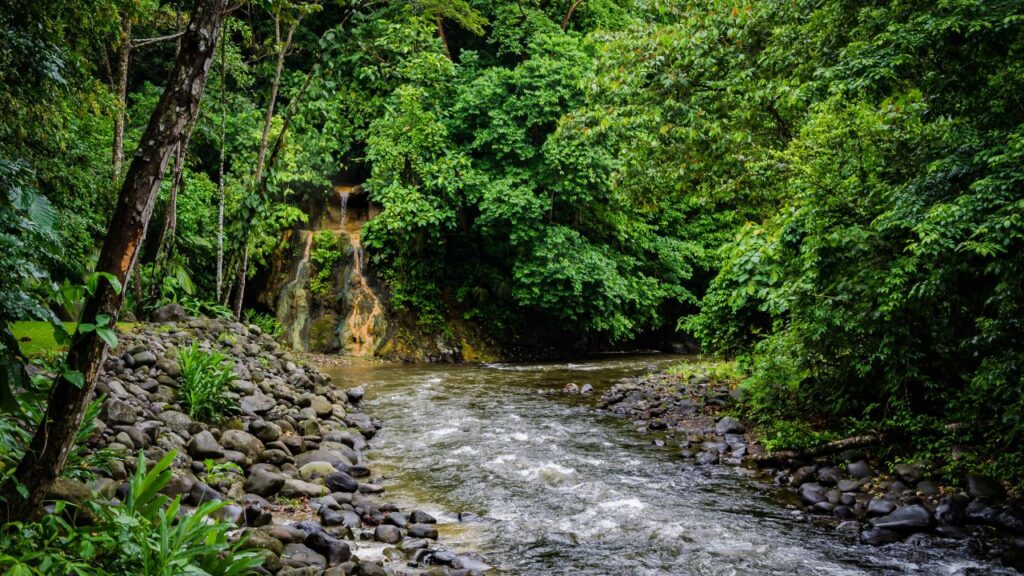
A Comprehensive Guide to the Volcanoes of Costa Rica 22
- Respect Park Regulations: Follow the rules and guidelines set by the national parks and authorities. Stay on designated trails, avoid disturbing wildlife, and heed safety advisories.
- Pack Layers and Rain Gear: Costa Rica’s volcanic regions can experience sudden weather changes. Pack layers to adapt to varying temperatures and include a waterproof jacket or poncho for unexpected rain.
- Binoculars and Camera: Don’t forget to bring binoculars and a camera with extra batteries. The diverse wildlife and stunning vistas are worth capturing and observing up close.
- Comfortable Footwear: Sturdy, comfortable hiking shoes are a must. Some trails can be rocky or muddy, so proper footwear will make your explorations more enjoyable.
- Guided Tours: Consider hiring a knowledgeable guide for a deeper understanding of the volcanic landscapes, local culture, and wildlife. They can enhance your experience and ensure safety.
- Early Mornings: If you’re planning to explore popular areas, consider starting your day early to avoid crowds and enjoy cooler temperatures.
- Insect Repellent: In tropical environments, insects are common. Carry insect repellent to protect yourself from bites, especially during dawn and dusk.
- Hydration and Snacks: Carry a reusable water bottle to stay hydrated during your hikes. Pack energy-rich snacks to keep your energy levels up throughout the day.
- Leave No Trace: Practice responsible tourism by leaving no trace of your visit. Dispose of waste
Packing Essentials for Your Volcanic Adventure

A Comprehensive Guide to the Volcanoes of Costa Rica 23
- Sturdy Hiking Shoes: Comfortable and supportive footwear is crucial for exploring uneven terrain and hiking trails around the volcanoes.
- Layers of Clothing: Pack a mix of lightweight and warmer clothing layers to accommodate changing weather conditions, including moisture-wicking shirts, a light jacket, and a warmer layer for cooler moments.
- Rain Gear: A waterproof jacket or poncho will keep you dry during unexpected rain showers and misty conditions common in volcanic areas.
- Hat and Sunglasses: Protect yourself from the sun’s rays with a wide-brimmed hat and polarized sunglasses.
- Sunscreen and Bug Repellent: Shield your skin from the sun and insects with sunscreen (SPF 30 or higher) and effective bug repellent.
- Reusable Water Bottle: Stay hydrated by carrying a refillable water bottle to sip on during your hikes.
- Backpack: A lightweight, comfortable backpack is essential for carrying your water, snacks, camera, and other essentials.
- Camera and Binoculars: Capture the stunning vistas and wildlife with a camera and binoculars for closer observation.
- First Aid Kit: A basic first aid kit with bandages, antiseptic, pain relievers, and any personal medications is essential for unexpected situations.
- Trail Snacks: Energy bars, nuts, and dried fruits provide quick and convenient sustenance during hikes.
- Portable Charger: Ensure your electronics, such as your phone and camera, stay powered with a portable charger.
- Multi-tool or Pocket Knife: A versatile tool can come in handy for various tasks during your adventure.
- Maps and Guides: Carry physical maps or guidebooks for navigation and learning about the area’s geology, flora, and fauna.
- Travel Documents: Keep your passport, ID, travel insurance, and any necessary permits in a waterproof pouch.
- Personal Toiletries: Bring travel-sized toiletries, including hand sanitizer, wet wipes, and tissues.
- Cash and Card: Carry a mix of local currency and a credit card for purchases and emergencies.
- Lightweight Towel: A quick-drying, compact towel is useful for wiping off sweat or for impromptu dips.
- Hiking Poles: Depending on the terrain and your preference, collapsible hiking poles can provide stability and reduce strain on your joints.
- Travel Adapter: If you’re bringing electronic devices, ensure you have the appropriate travel adapter for Costa Rica’s outlets.
- Notepad and Pen: Document your experiences, observations, and thoughts in a travel journal.
By packing these essentials, you’ll be well-prepared to embark on a memorable volcanic adventure while ensuring comfort, safety, and enjoyment throughout your journey in Costa Rica’s captivating landscapes.
Volcano Tour Guide: Safety Precautions in Volcanic Areas
- Stay Informed: Check with local authorities or park rangers for the latest information about volcanic activity and any safety advisories.
- Follow Park Rules: Adhere to designated trails, viewpoints, and safety barriers to avoid unstable areas and protect fragile ecosystems.
- Weather Awareness: Be prepared for changing weather conditions by packing appropriate clothing layers, rain gear, and sun protection.
- Hiking Preparation: Inform someone about your hiking plans and estimated return time. Stay on marked trails and avoid taking unnecessary risks.
- Volcano Activity: Research the current activity status of the volcano you plan to visit and respect any restricted areas.
- Gas and Steam: Avoid venturing into areas with visible gas emissions or steam vents, as they can be hazardous.
- Lava Flows: Stay at a safe distance from active lava flows, and never approach areas with flowing or molten lava.
- Emergency Contacts: Keep a list of emergency contacts, including local authorities, your embassy, and the nearest medical facilities.
- Wildlife Caution: While observing wildlife, maintain a safe distance and avoid feeding or approaching animals.
- Altitude Awareness: Be mindful of altitude changes and stay hydrated to prevent altitude sickness.
- Earthquake Preparedness: Some volcanic regions are prone to earthquakes. Familiarize yourself with earthquake safety measures.
- Travel Insurance: Ensure you have comprehensive travel insurance that covers medical emergencies, evacuations, and trip cancellations.
- Respectful Photography: While taking photos, be respectful of local culture, sacred sites, and fellow visitors.
- Natural Hazards: Be cautious of potential hazards like falling rocks, sudden weather changes, and slippery surfaces.
- Local Guidance: If you’re participating in guided tours or activities, follow the instructions of trained guides at all times.
- Personal Health: Ensure you’re in good physical condition before embarking on strenuous activities. If you have any health concerns, consult a doctor.
- Children and Pets: If traveling with children or pets, prioritize their safety by keeping them close and following safety guidelines.
- Stay Hydrated: Drink water regularly to stay hydrated, especially in warm and high-altitude environments.
- Emergency Kit: Carry a basic first aid kit, along with essentials like a flashlight, whistle, and multi-tool.
- Use Common Sense: Trust your instincts and use common sense when making decisions in unfamiliar environments.
By following these safety precautions, you can enjoy your volcanic adventure in Costa Rica with peace of mind, ensuring a memorable experience while prioritizing your well-being and that of others.
Conclusion: Embracing the Dynamic Beauty of Costa Rica’s Volcanoes
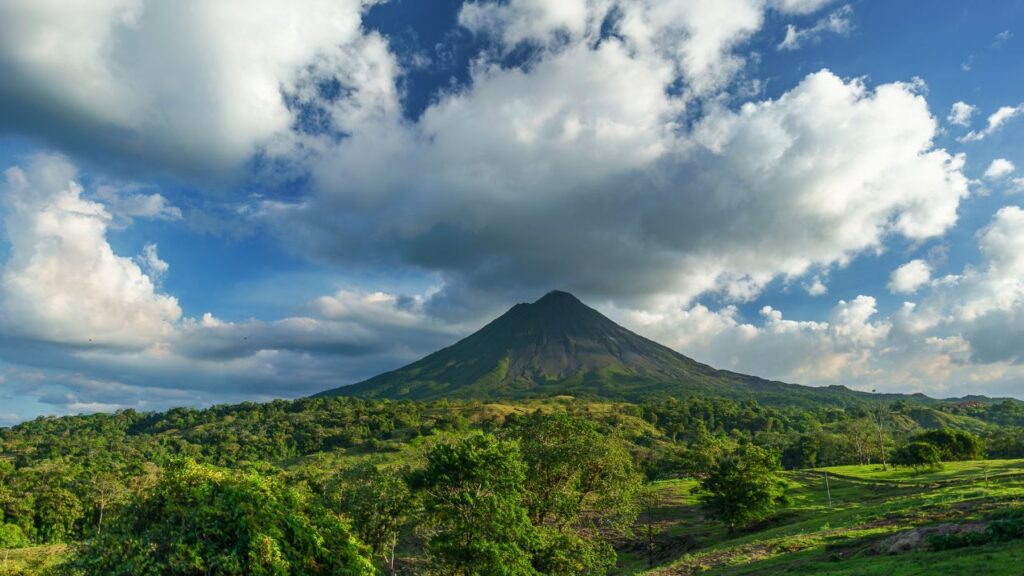
A Comprehensive Guide to the Volcanoes of Costa Rica 24
The volcanic landscapes of Costa Rica showcase a blend of natures captivating elements. Raw power, exquisite beauty and delicate ecological balance. These majestic volcanoes hold stories that span thousands of years shaping the foundation beneath our feet and providing a glimpse into the forces that shape our planet. From the awe-inspiring displays of volcanoes, to the charm of crater lakes and verdant cloud forests each volcanic destination in Costa Rica unveils a unique chapter in this geological saga.
Embracing the changing splendor of Costa Rica’s volcanoes is not just an adventure; it is an expedition, into Earth’s grandeur and an opportunity to connect with nature in its form. As you venture along the trails witness the mesmerizing wonders and listen to the calls of wildlife you will be fully immersed in a symphony of life thriving in the shadows cast by these towering giants. Whether you seek heart-pounding excitement, peaceful relaxation or a deeper understanding of Earth’s processes Costa Rica’s volcanic regions offer an array of experiences tailored to satisfy every traveler’s curiosity.
As you traverse these landscapes remember that you are not merely observing but actively participating in Earth’s evolution. Costa Rica’s volcanoes call upon you to escape the ordinary and enter a realm of awe-inspiring beauty. With each view, volcanic crater and passing second nature unveils its masterpiece. So let your journey be fueled by curiosity, admiration, and a profound gratitude, for the captivating landscapes of Costa Rica’s marvels.
For a detailed exploration of Costa Rica’s majestic volcanoes, inviting you to a journey filled with enriching experiences, do visit our blog. If you have any questions or need further assistance, feel free to reach out via WhatsApp. We’re here to ensure your volcanic adventure is truly unforgettable!

